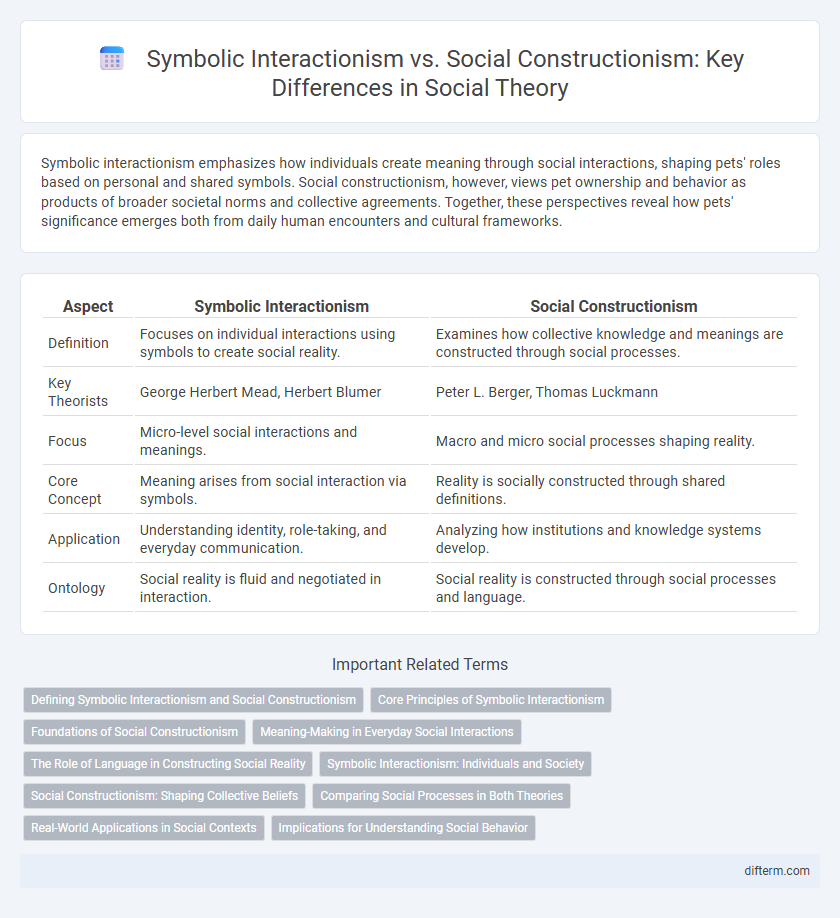Symbolic interactionism emphasizes how individuals create meaning through social interactions, shaping pets' roles based on personal and shared symbols. Social constructionism, however, views pet ownership and behavior as products of broader societal norms and collective agreements. Together, these perspectives reveal how pets' significance emerges both from daily human encounters and cultural frameworks.
Table of Comparison
| Aspect | Symbolic Interactionism | Social Constructionism |
|---|---|---|
| Definition | Focuses on individual interactions using symbols to create social reality. | Examines how collective knowledge and meanings are constructed through social processes. |
| Key Theorists | George Herbert Mead, Herbert Blumer | Peter L. Berger, Thomas Luckmann |
| Focus | Micro-level social interactions and meanings. | Macro and micro social processes shaping reality. |
| Core Concept | Meaning arises from social interaction via symbols. | Reality is socially constructed through shared definitions. |
| Application | Understanding identity, role-taking, and everyday communication. | Analyzing how institutions and knowledge systems develop. |
| Ontology | Social reality is fluid and negotiated in interaction. | Social reality is constructed through social processes and language. |
Defining Symbolic Interactionism and Social Constructionism
Symbolic interactionism defines social reality through individuals' everyday interactions and the meanings they assign to symbols, language, and gestures. Social constructionism emphasizes that knowledge and social phenomena are co-created through collective agreements and cultural practices within a society. Both perspectives highlight the dynamic and interpretive nature of social life, yet symbolic interactionism centers on micro-level interactions while social constructionism addresses broader societal frameworks.
Core Principles of Symbolic Interactionism
Core principles of symbolic interactionism emphasize the importance of symbols and language as fundamental components in human interaction, enabling individuals to create shared meanings within social contexts. The theory centers on the idea that people act based on the meanings things have for them, which are derived from social interaction and modified through interpretation. This dynamic process contrasts with social constructionism, which focuses more broadly on the collective construction of social realities through discursive practices.
Foundations of Social Constructionism
Symbolic interactionism centers on how individuals create meaning through social interactions, emphasizing micro-level processes. Foundations of social constructionism assert that reality is constructed through collective agreement, cultural norms, and shared language at a macro level. This framework highlights that knowledge and social realities are not objective but shaped by social processes and historical contexts.
Meaning-Making in Everyday Social Interactions
Symbolic interactionism emphasizes the dynamic process of meaning-making through face-to-face interactions, where individuals interpret and negotiate symbols to construct social reality. Social constructionism expands this perspective by highlighting how collective agreements and shared understandings shape broader social structures and cultural norms. Both frameworks underscore that meanings are not fixed but continuously created and modified through everyday social interactions.
The Role of Language in Constructing Social Reality
Language serves as a fundamental tool in symbolic interactionism, where individuals create and interpret shared meanings through social interactions, shaping their understanding of reality. In social constructionism, language functions as a medium through which societies collectively construct and maintain social norms, identities, and institutions. Both perspectives emphasize that language is not merely a communication tool but a key mechanism in constructing and negotiating social reality.
Symbolic Interactionism: Individuals and Society
Symbolic Interactionism explores how individuals create meaning through social interactions by using symbols, language, and gestures, emphasizing micro-level processes in society. This theory highlights the role of self-concept development and role-taking in shaping behavior and social reality. It contrasts with Social Constructionism by focusing more on individuals' interpretations within everyday interactions rather than broader social structures.
Social Constructionism: Shaping Collective Beliefs
Social constructionism emphasizes the ways in which collective beliefs and social realities are created through shared language, symbols, and interactions within a society. It argues that knowledge and meaning are not inherent but are constructed through social processes, influencing identities, institutions, and cultural norms. By analyzing how social phenomena are shaped, social constructionism reveals the power of collective agreement in defining what is perceived as real or true.
Comparing Social Processes in Both Theories
Symbolic interactionism centers on micro-level social interactions where individuals create and interpret symbols to develop social reality, emphasizing face-to-face communication and meaning-making processes. Social constructionism operates at both micro and macro levels, highlighting how collective agreements and social institutions construct shared realities through language, culture, and power dynamics. Both theories explore the dynamic, ongoing social processes that shape human understanding, though symbolic interactionism focuses more on individual interactions, while social constructionism stresses broader societal narratives.
Real-World Applications in Social Contexts
Symbolic interactionism shapes real-world social interactions by emphasizing how individuals create meaning through shared symbols in everyday communication. Social constructionism influences societal norms and institutions by highlighting that social realities are constructed through collective agreement and cultural practices. Both theories guide practical approaches in education, therapy, and organizational development by fostering understanding of how social meanings and identities are formed and maintained.
Implications for Understanding Social Behavior
Symbolic interactionism emphasizes the micro-level interactions and the meanings individuals assign to symbols, shaping their social behavior through continuous interpretation and negotiation. Social constructionism highlights how larger social realities and knowledge are collectively constructed through shared discourses and cultural practices, influencing behavior by defining norms and expectations. Understanding social behavior requires integrating both perspectives to grasp how personal interactions and broader social frameworks co-produce meaning and guide human actions.
symbolic interactionism vs social constructionism Infographic

 difterm.com
difterm.com